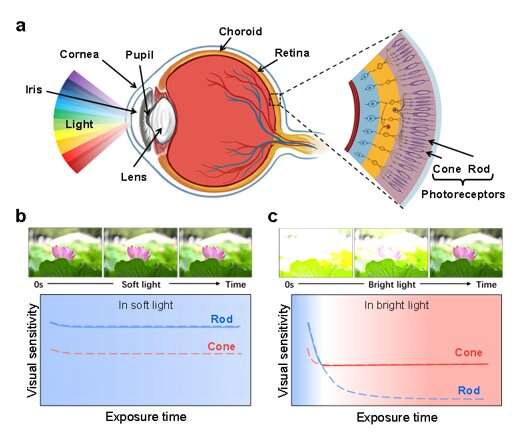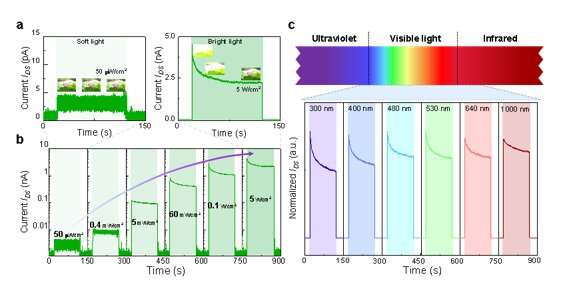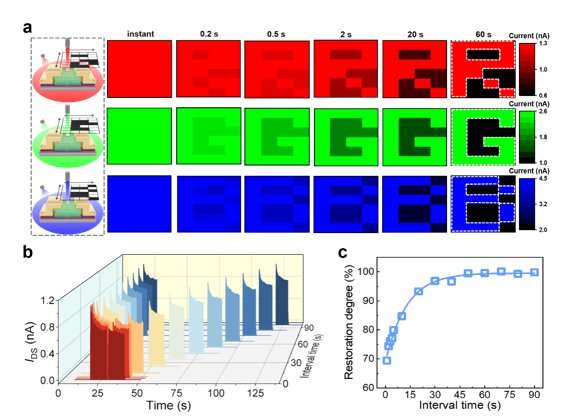This article has been reviewed according to Science X's editorial process and policies. Editors have highlighted the following attributes while ensuring the content's credibility:
fact-checked
peer-reviewed publication
trusted source
proofread
Self-powered and broadband opto-sensor with bionic visual adaptation function

Recently, an artificial visual device with integrated visual adaptation functions was proposed by Professor Xu Haiyang's group from Key Laboratory of UV-Emitting Materials and Technology of Ministry of Education, Northeast Normal University, China.
The device can operate in self-powered mode and exhibit good human-eye-like adaptation behaviors, which include broadband light-sensing image adaptation (from ultraviolet to near-infrared), near-complete photosensitivity recovery (99.6%), and synergetic visual adaptation, encouraging the advancement of intelligent opto-sensors and machine vision systems.
Visual perception, a vital sensing functionality for human beings and other vertebrates, contributes more than 80% of the perceptual information from the ambient environments to the brain. With the rapid development of artificial intelligence, artificial visual systems are demanded to be able to mimic the visual perception capabilities of biological systems. Among them, an important functionality is visual adaptation, which can automatically adjust the response to stimuli according to different light environments.
However, the existing efforts on mimicking visual adaptation functions have been trapped in complicated hardware and algorithms that typically reduce operating efficiency. Ideally, a new generation of artificial visual systems with adaptation functions should have a simpler structure and lesser logic operations.
Unfortunately, their main mechanisms are still restricted to modulation of carrier trapping or ion migration, which are inadequate for the future development of visual adaptive devices and artificial visual systems. Hence, it is highly desired to explore more working mechanisms to serve the visual adaptation function of artificial visual systems that possess simple device architectures.
-

Light-intensity-dependent and broadband response. Credit: Weizhen Liu, Xuhui Yang, Zhongqiang Wang, Yuanzheng Li, Jixiu Li, Qiushi Feng, Xiuhua Xie, Wei Xin, Haiyang Xu, and Yichun Liu -

Bioinspired visual adaptation functions of the γ-InSe opto-sensor. Credit: Weizhen Liu, Xuhui Yang, Zhongqiang Wang, Yuanzheng Li, Jixiu Li, Qiushi Feng, Xiuhua Xie, Wei Xin, Haiyang Xu, and Yichun Liu
In this work, a two-terminal opto-sensor based on γ-InSe flake is experimentally demonstrated to emulate the human visual adaptation. The main working mechanism for the dynamic adaptation is confirmed to be the synergy of photo-pyroelectric effect and photo-thermoelectric effect.
Because the γ-InSe opto-sensor can act as a self-powered device, benefiting from the photocarrier separation induced by the built-in electric field at the Schottky junction interfaces between gold electrodes and γ-InSe, emulate the human visual adaptation ranging from ultraviolet to near-infrared light.
More importantly, the device can exhibit good human-eye-like adaptation behaviors, which include broadband light-sensing image adaptation (from ultraviolet to near-infrared), near-complete photosensitivity recovery (99.6%), and synergetic visual adaptation, encouraging the advancement of intelligent opto-sensors and machine vision systems.
The research is published in the journal Light: Science & Applications.
More information: Weizhen Liu et al, Self-powered and broadband opto-sensor with bionic visual adaptation function based on multilayer γ-InSe flakes, Light: Science & Applications (2023). DOI: 10.1038/s41377-023-01223-1
Journal information: Light: Science & Applications
Provided by Chinese Academy of Sciences





















